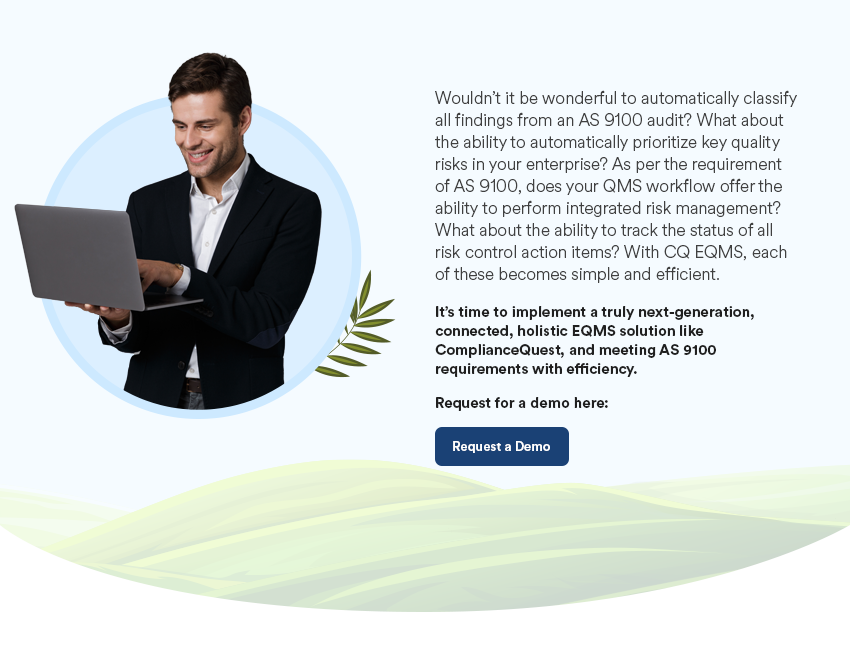Quality Management in the Aerospace Sector
According to a McKinsey1 finding, the global aerospace and defense sector can create incremental annual EBITDA of $20 billion by embracing better digital transformation. This can be ensured by improving the operations at the OEM and supplier ends, expanding markets, and lowering costs across the value chain -- including engineering, manufacturing, supply chain and procurement, aftermarket services, and support functions.
Of course, at the core of all of these processes is top-notch quality performance. And, the first step towards better quality is to automate the process of meeting regulatory requirements and staying in line with standards such as AS 9100.
Benefits of Implementing AS 9100
By implementing AS 9100, aerospace companies can benefit from:
- Improved compliance with global regulations and standards including the U.S. Government and Department of Defense
- Improved return on investment
- Increased customer satisfaction
- Enhanced effectiveness due to process improvement through the use of data for review and management
- Comprehensive documentation and analytics for continuous improvement
- Increased employee involvement
ISO 9001:2015, one of the most recognized quality standards, facilitates improved satisfaction of all stakeholders of a business, most importantly customer satisfaction. It enables building a quality framework for ensuring consistency of the quality of goods and/or services. It takes a risk-based approach and encourages the automation of processes for greater transparency and accountability.
AS 9100 is adopted from ISO 9001 but is further customized for companies in the aerospace sector.
The standard is based on seven quality management principles:
- Customer Focus
- Leadership:
- Engagement of People
- Process-oriented Approach
- Improvement
- Evidence-based Decision Making
- Relationship Management
The principles can vary in importance in different organizations and over a period of time, based on the growth stage, challenges, etc. the company is facing.
The standard emphasizes the need for businesses to understand the context of their organization when implementing AS 9100.
Identifying the context involves:
- Conducting internal/external audits
- Understanding the needs and expectations of the stakeholders
- Determining the scope of the Quality Management System
- Ensuring leadership commitment
- Document management
- Training management
- Defining organization roles, responsibilities, and authorities
- Identifying risks and opportunities
- Change management
- Communication and collaboration
A uniting factor across businesses is the need for digital transformation and automation for improved quality management and compliance with the ISO 9001 standard. Digital technologies such as AI, data analytics, and cloud are crucial for building an enterprise-wide culture of quality.
Aerospace Sector: Critical Requirements
The ISO standard applicable to the aerospace industry is AS 9110 D, which, along with ISO 9001:2015, provides guidance to aircraft and aircraft parts manufacturers with best practices to ensure product quality. All primary and secondary parts suppliers and IAQG-accredited aircraft repair and maintenance units must be aligned to these standards to ensure better quality, lower cost, and enhanced delivery performance.
The aerospace industry is highly globalized, requiring it to meet varied regional/national expectations, regulations, and standards. The responsibility of ensuring the quality of the end-product after integrating components sourced from suppliers from across the world falls on the OEM. Compliance can become a challenge. But with a diligent alignment of operations to the AS 9100 standard, aerospace manufacturers can benefit in the following ways:
- Operational Risk Management: A risk-based approach helps businesses proactively identify and mitigate risks to operations by defining the risk assessment criteria, assigning responsibilities, communicating, managing, mitigating, or accepting based on the pre-defined threshold, to improve operational efficiency.
- Configuration Management: Identify and control physical and functional attributes during the product lifecycle using configuration management to enhance traceability, accuracy, and ensure documentation.
- Training: Identify gaps and plan appropriate training programs based on the role to discharge one’s responsibility better.
Automation of AS 9100 Processes
A solution such as ComplianceQuest is mapped to the ISO/AS 9100 requirements and helps with automating quality workflows for greater efficiency and effectiveness of the quality management system.
ComplianceQuest EQMS is a cloud-based, AI-enabled solution that helps build the smart framework required to make quality management effective and efficient. It helps with a variety of functions, including:
- Audit management
- CAPA for continuing improvement
- Change management
- Complaints Management to create loyalty by addressing customer complaints smartly
- Document management for relevant information to be within reach always
- Equipment management for keeping the tools of the trade in top condition
- Inspection management
- Nonconformance management across departments and locations
- Risk management
- Supplier management
- Training
Built on the Salesforce platform, ComplianceQuest helps businesses experience the benefits of automating their quality process across the enterprise right from design to continuous improvement.


